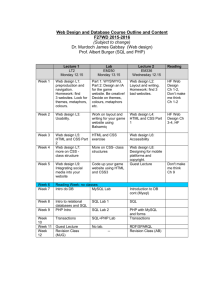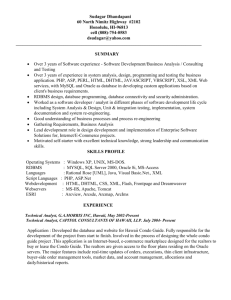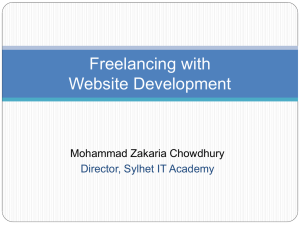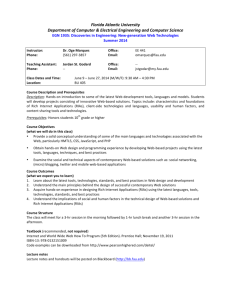Web Programming - COMP2145 Learning Design Information
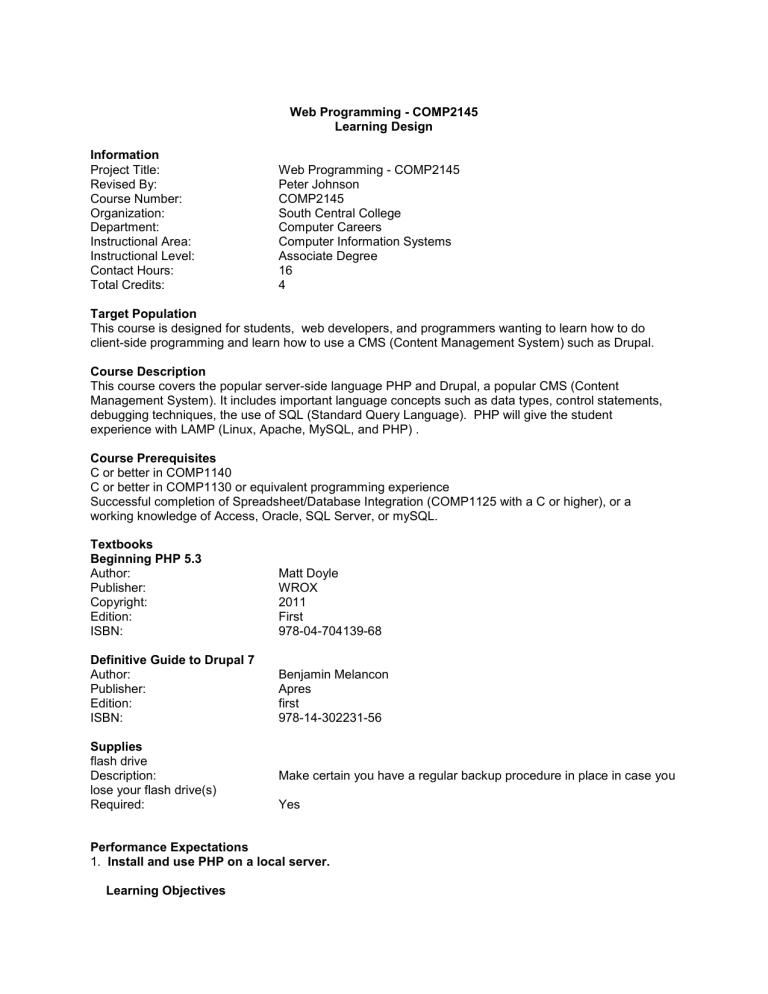
Web Programming - COMP2145
Learning Design
Information
Project Title:
Revised By:
Course Number:
Organization:
Department:
Web Programming - COMP2145
Peter Johnson
COMP2145
South Central College
Computer Careers
Instructional Area:
Instructional Level:
Contact Hours:
Total Credits:
Computer Information Systems
Associate Degree
16
4
Target Population
This course is designed for students, web developers, and programmers wanting to learn how to do client-side programming and learn how to use a CMS (Content Management System) such as Drupal.
Course Description
This course covers the popular server-side language PHP and Drupal, a popular CMS (Content
Management System). It includes important language concepts such as data types, control statements, debugging techniques, the use of SQL (Standard Query Language). PHP will give the student experience with LAMP (Linux, Apache, MySQL, and PHP) .
Course Prerequisites
C or better in COMP1140
C or better in COMP1130 or equivalent programming experience
Successful completion of Spreadsheet/Database Integration (COMP1125 with a C or higher), or a working knowledge of Access, Oracle, SQL Server, or mySQL.
Textbooks
Beginning PHP 5.3
Author: Matt Doyle
Publisher:
Copyright:
Edition:
ISBN:
Definitive Guide to Drupal 7
Author:
Publisher:
WROX
2011
First
978-04-704139-68
Edition:
ISBN:
Supplies flash drive
Description: lose your flash drive(s)
Required:
Benjamin Melancon
Apres first
978-14-302231-56
Make certain you have a regular backup procedure in place in case you
Yes
Performance Expectations
1.
Install and use PHP on a local server.
Learning Objectives
a. Describe Open Source software and why it is effective for improved software development. b. Draw a picture describing the relationship between client/server objects used by PHP and mySQL. c. Install PHP and mySQL and an Apache web server. d. Write a simple test program using PHP on the local server (http://localhost/ ) e. Establish a working environment for PHP web page development. f. Use variables, constants, and environment variables in a PHP program.
2.
Utilize HTML forms and PHP to get information from the user.
Learning Objectives a. Create an HTML reference page showing all the form objects. b. Use GET and POST to send variables to a PHP web page. c. Use isset() to check for the existence of variables. d. Use urlencode() and urldecode() to pass strings of words via the URL (method="get")
3.
Utilize decision making constructs in a PHP program.
Learning Objectives a. Use the if else construct to make simple decisions. b. Use the switch statement to make multiple comparisons on a single variable. c. Use the for loop to iterate through a list d. Convert a for loop into a do while loop to demonstrate the simularities.
4.
Use functions and arrays as part of your code design.
Learning Objectives a. Write and use a function that receives parameters by value. b. Store the value of a value returned by a function in a variable. c. Demonstrate the use of indexed arrays. d. Demonstrate the use of associative arrays. e. Demonstrate the use of both local and global variables in a program. f. Use the keyword static to maintain a value inside of a function. g. Use the include( ) function to access functions stored in external files.
5.
Utilize two techniques to overcome the statelessness of the Web
Learning Objectives a. Utilize regular expressions to validate input from user. b. Use regular expressions to prevent SQL injection c. Use hidden fields to pass information to php modules. d. Use PHP Sessions to create persistent variables that can be used by multiple requests from a client browser session.
6.
Use File I/O to read and write to files.
Learning Objectives a. Use file functions to read information from disk files. b. Use file functions to write data to disk files. c. Get file property information from the directory. d. Copy, rename and delete files.
7.
Install mySQL and use phpMyAdmin
Learning Objectives a. Connect to a database. b. Use mysql_query( ) to perform SQL statements.
c. Use phpMyAdmin to administer databases, tables, and fields.
8.
Use SQL
Learning Objectives a. Create a table using SQL b. Add new data to a table using SQL c. Update records using SQL d. Delete records using SQL e. Query multiple tables using simple joins f. Query multiple tables using inner and outer joins g. Use stored procedures h. Demonstrate how stored procedures can prevent security breaches.
9.
Install a CMS such as Drupal
Learning Objectives a. Install Drupal on a local web server. b. Install Drush. c. Set up users with different roles and permissions. d. Change and modify themes.
10.
Create and Edit Content
Learning Objectives a. Describe what a node is. b. Utilize URL aliases. c. Create a 'Contact Us' page. d. Create a menu system. e. Add content nodes to a menu item. f. Create a new content type.
11.
Extract Data for Different Views
Learning Objectives a. Install new modules. b. Use shortcuts on the menu bar. c. Find content that doesn't have a menu item. d. Update URL aliases for a specific content type. e. Create a new SQL view. f. Add new fields to the SQL view. g. Rewrite the output of a field to include other fields. h. Adjust the order of content in a view. i. Add and configure a date field.
12.
Set up a Taxonomy
Learning Objectives a. Give a real-life example of the use of taxonomy. b. Add taxonomy vocabulary with terms. c. Add a taxonomy term reference field to a content type. d. Link a Views field to other related content. e. Add an autocomplete (free tagging) field to a content type.
13.
Utilize Blocks and Permissions
Learning Objectives a. Describe the difference between a block and a region. b. Hide user login fields and other blocks. c. Add a "log in" option to a user menu. d. Configure search. e. Set up a cron run. f. Describe how permissions relate to roles. g. Demonstrate different text formats.
14.
Implement a WYSIWYG Editor and Media Handler
Learning Objectives a. Configure HTML filters. b. Install a WYSIQYG editor for better UX. c. Describe how program libraries work d. Modify the WYSIWYG CSS editor settings. e. Install a media handling program. f. Coordinate the media handling program with the WYSIWYG editor. g. Configure styles available with the WYSIWYG editor. h. Troubleshoot line break/paragraph problems with the WYSIWYG i. Set up a custom 404 "page not found" error page.
15.
Use CSS to Theme a Site
Learning Objectives a. Inspect any element on a page using browser tools. b. Apply CSS styles to the proper selector. c. Describe what the CSS Injector module does. d. Add a custom CSS stylesheet to certain pages. e. Hide breadcrumbs (or any element) using CSS. f. Use Drush to update modules. g. Change the font size of menu items.
16.
Create a Module using PHP Coding
Learning Objectives a. Describe why the site cache has to be cleared. b. Build a module scaffolding with an .info and .module file. c. Implement at least three different hook functions. d. Display a block using hook_block_view( ). e. Describe the naming conventions used with hook functions using examples. f. List eight coding standards. g. Describe why coding standards are so important with an open-source project. h. Use the l( ) and t( ) functions appropriately.
17.
Customize and Manipulate Forms & Menus
Learning Objectives a. Create an embedded form. b. Add usability using the #states attribute. c. Describe what a menu callback does. d. Add a new page without a menu item. e. Pass arguments using the path. f. Create dynamic titles with a title callback. g. Modify page output using hook_page_alter( ). h. Modify menu output using hook_menu_alter( ).
18.
Customize and Manipulate Themes
Learning Objectives a. Invoke a theme function. b. Describe how the theme registry works. c. Create a template file. d. Use preprocessing functions. e. Add CSS files in theme functions and template files. f. Override the theme functions using hook_theme_alter().
19.
Interact with the Database
Learning Objectives a. >Build a database table in an external application. b. Write an INSERT SQL query using the Database API. c. List the four benefits of using the Database API. d. Write a DELETE SQL query using the Database API. e. Write a dynamic SELECT query and paginate the result. f. Add utility queries for CRUD.
20.
Work with Users
Learning Objectives a. Modify the user settings form. b. Save data to an authenticated user. c. Respond to a user login/logout. d. Store anonymous user data in a cookie. e. Store user data in a session variable.
21.
Work with Nodes
Learning Objectives a. Load and view multiple nodes at once. b. Manipulate node data with node_save( ). c. Add custom data to a node with hook_node_insert( ) and hook_node_update( ). d. Add a custom view mode. e. Control node-based access using hook_node_access(). f. Add a new node type with a module. g. Add a custom field formatter.
22.
Incorporate JavaScript and jQuery
Learning Objectives a. Include a JavaScript file on every page of the site. b. Use jQuery to add interactivity to a page. c. Manipulate CSS using jQuery. d. Use hook_library_alter( ) to see what JavaScript libraries are available. e. Use Ajax to load dynamic HTML, CSS, and JavaScript. f. List at least four JavaScript utilities that are included in the core.
